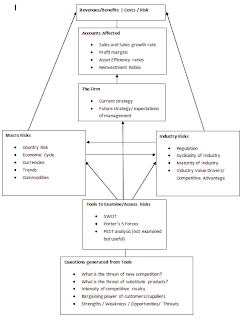Corporate Valuations: Where do we find ourselves?
I
find it useful to stop at times and check through the rear-view mirror to
ensure that the work that I am doing follows some kind of plan. The purpose of
this post is to understand where we are, how we got here, and how the material
examined so far fits in to a valuation strategy. When you approach a valuation,
you are looking at a complex system (that comprises of many smaller
inter-connected systems) and trying to break it down. The complex system
includes the firm, its various operations and investments, and the financing
that it has attracted. It also includes the firm’s direct operating environment
(i.e. the industry) and the external economic environment. We need to
understand what is happening in the external environment, but more importantly,
we need to appreciate how the firm and its industry fit into their surroundings.
Is it an industry that is attracting capital at a greater rate than other
industries or is it an industry that is contracting? – these are questions that
need to be asked for which the answers will allow you to build your own valuation
system.
We introduced this semester by discussing the various
valuations approaches that are available to ‘valuation enthusiasts’ (and those
maybe not as keen). Though intrinsic (fundamental) valuation gives us the best
chance of identifying ‘errors’ in market values, other valuation methods like
comparable companies (multiples) are also quite useful. Real option valuation
is a third stream of valuation, though it is usually only encountered in
special circumstances. Intrinsic valuation starts with an understanding of financial
statements – the more knowledgeable you are in this area, the better your
valuation will be. Though many of you will have found the material here quite
basic, I find it serves a useful cause in that it helps to remind us what is
most important in a valuation. For example, not all assets in a balance sheet
are important – it is only the core assets of the firm that are truly necessary
in any forecast. What is working capital?; How do we measure capital
expenditure?; How can we delineate between discretionary/non-discretionary
CAPEX?; and what is invested capital?; – these are questions that we can only answer
if we truly understand the various elements that make up our financial
statements. It also gives us the confidence to be able to start building
pro-forma statements.
Pro-forma statements are statements of projection. They are
created by us, and therefore contain our expectations, beliefs, and our biases.
We create them not to guess how close we can get to the real thing but rather
to derive future cash flows based on the operating/external environment that we
expect. We are effectively trying to determine the returns that are most likely
and the costs and risks that will be incurred to make this happen. I like to look
at the problem in this way (see figure). It’s a little chaotic but the bottom
line here is that the system we are looking at features many sub-systems that
are affected by exogenous influences. For example, how will a change in
economic growth in Australia impact on a company? How will tighter regulation,
affect an industry, and subsequently the flow of capital to that industry?
These questions allow us to build our risk / growth expectations which will
serve to drive our final valuation estimate. That’s the next step!

Comments